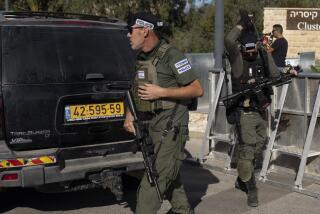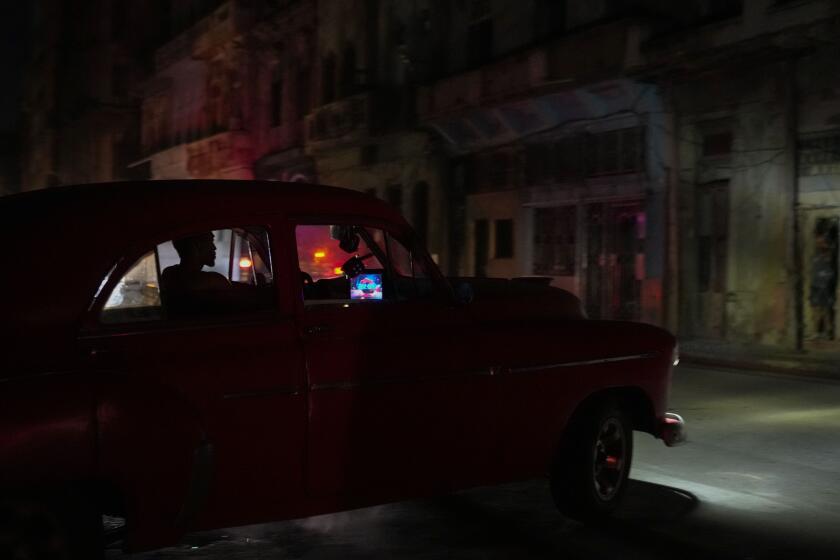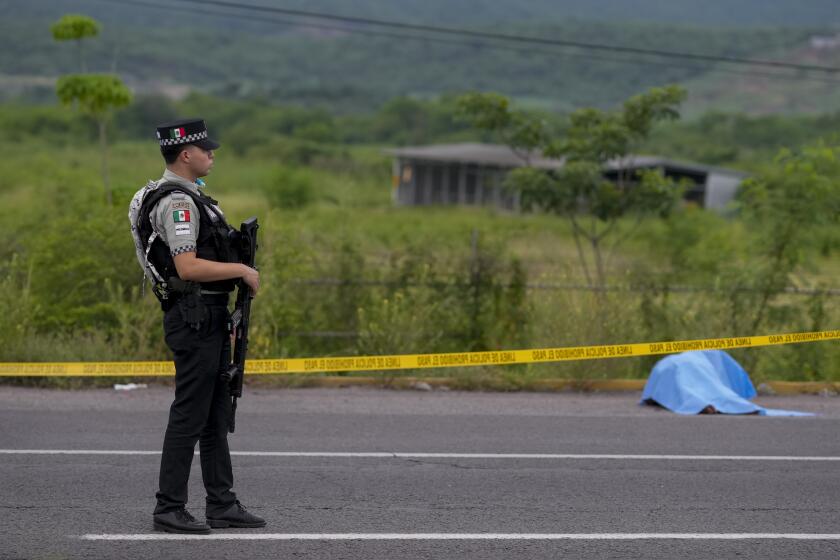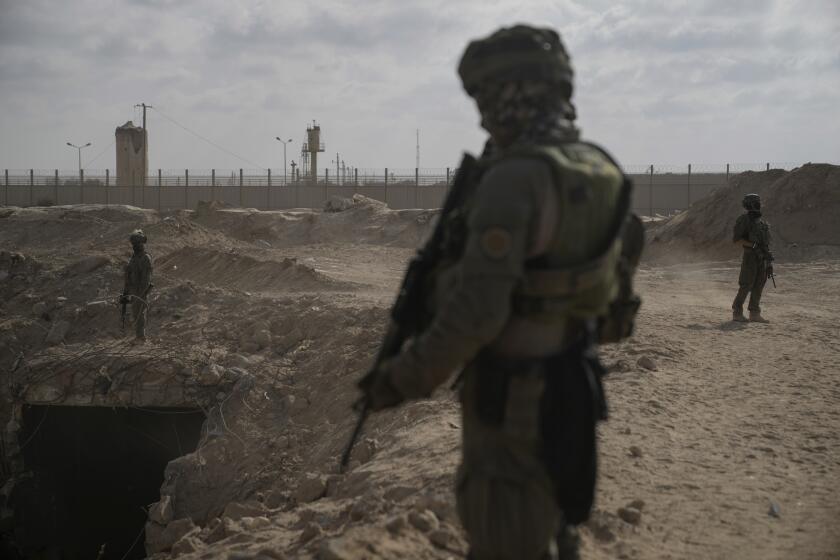Hijacking of Iraqi Jetliner Still Shrouded in Mystery
A series of unanswered questions persists about the events surrounding the crash of a hijacked Iraqi airliner in Saudi Arabia last week, an incident being described here as having caused one of the greatest losses of life ever to occur in an act of air piracy.
The questions run the gamut from such basic data as how many people were aboard when the plane crashed Thursday near a remote airstrip south of the Saudi-Iraqi frontier to the mystery of how the armed hijackers managed to get aboard.
Against the background of official secrecy, survivors have painted a horrific picture of a midair battle involving grenade explosions and exchanges of gunfire as security men, shouting “Long Live Saddam Hussein!” in salute to Iraq’s president, fired their weapons down the aisle.
The paucity of information is explained in part by the fact that Iraq, which owned the plane and was the starting point of the flight, is one of the world’s most secretive regimes, refusing to disclose even basic information about its economy.
The Iraqis, for example, still refused to release such fundamental information as a passenger list several days after the event.
Privately, Jordanian and Egyptian officials have expressed outrage at Iraq’s behavior because of the suffering it has caused relatives and friends of passengers, most of whom were Sudanese, Egyptian and Jordanian.
Another reason is that Saudi Arabia, where the aircraft crashed en route from Baghdad to the Jordanian capital of Amman, has been especially evasive about the incident, in apparent fear of being unwittingly drawn into the underlying political dispute that led to the hijacking. A measure of the fear is the fact that Saudi authorities have only obliquely confirmed that a hijacking took place at all.
The plane, a Boeing 737 belonging to Iraqi Airways, crashed on Christmas Day about 800 yards from the runway at Arar, in northern Saudi Arabia.
The Iraqis have made only brief statements about the incident, blaming the hijacking on “agents of Iran.”
It said there were two hijackers aboard the plane, who had arrived in Baghdad in transit from Yugoslavia on Lebanese passports.
Late Sunday, Iraq said that 65 people died in the disaster, the Associated Press reported. The Baghdad government identified the two hijackers, both reported killed either in the shoot-out with security agents or in the subsequent crash, as Elia Georges Hana and Ziad Hana Asmar. It did not say if they were related or give any other details, but the names indicated they were Lebanese Christians.
The official Iraqi News Agency, monitored in Nicosia, Cyprus, said that 23 Iraqis, 22 Sudanese, 14 Egyptians, two Jordanians, two Palestinians with Jordanian passports and the two hijackers, who carried Lebanese passports, were killed. The agency did not say how many survived.
Saudi Arabia has maintained that 62 people died and 32 were injured. The Saudis said there were 91 passengers, 15 crew members and a security guard on board but that one person was still not accounted for. There was no immediate explanation for the discrepancy.
So far, Saudi Arabia’s only acknowledgment that the incident involved a hijacking came in a dispatch by the Saudi news agency, which quoted an unidentified official as denying reports from Beirut that the plane was being forced to land at Arar by Saudi warplanes.
Two surviving passengers, Suleiman Aarar, a former Jordanian interior minister, and Salim Adel Dado, a Jordanian businessman, have repeatedly said since their return home last Thursday that at least one hijacker survived the crash and was taken to the hospital. Aarar said that he even overheard the survivor speaking with another hijacker, who referred to the first man by the name “Ghassan.”
Both Aarar and Dado believe there were four hijackers on the plane, although Aarar acknowledged having seen two and Dado only one.
The survivors agree that the ordeal began about an hour after the plane left Baghdad when a security guard shot one of the hijackers as he ran from the economy section to the first-class cabin and hurled an explosive at the cockpit. Confusion produced by gunfire and explosions followed, and little is clear about the exact sequence of events.
The Iraqis have said that the two--and only--hijackers on the plane died, and the Saudis have not mentioned their fate. But Saudi officials have insisted that all injured passengers and crew members and the bodies of all the dead were sent immediately to Baghdad.
Some Jordanian officials have complained that Saudi Arabia’s apparent eagerness to rid itself of all such traces of the hijacking was reckless in light of the seriousness of the injuries some passengers and crew members suffered. Two Jordanians among the injured are reported to have died since the crash, and officials here expressed amazement that they were moved so quickly.
According to officials here, the Saudis were anxious to get the survivors from the hijacked plane off Saudi soil because within hours of the crash, callers in Beirut had begun threatening Saudi interests around the world.
Among the many stories circulating in Amman was a report that the Saudi authorities had detained surviving hijackers and planned to turn them over to Lebanese authorities to avoid retribution. But officials here seemed convinced that any surviving hijackers would have been sent to Iraq.
A telephone caller in Beirut said that the hijackers were members of Al Daawa, an Iran-supported Shia Muslim guerrilla movement active in opposition to President Hussein of Iraq. At the time of the hijacking, Al Daawa and a number of other Iraqi opposition organizations were holding a meeting in Tehran, the Iranian capital.
Another mystery is how such heavily armed hijackers managed to get aboard the Iraqi aircraft.
Saddam Hussein Airport, as the Baghdad terminal is called, is among the world’s most closely guarded airports. All baggage is X-rayed on arrival, and passengers are searched twice before boarding their planes.
In addition, Iraqi Airways imposes Draconian security measures, refusing to let any hand baggage aboard a departing aircraft. Women cannot even carry handbags.
The hijackers succeeded in bringing several explosive devices on board the flight. And the large numbers of shots fired suggested that they had guns as well.
While the answer is unknown, officials here speculated that one or more of the security guards may have helped the hijackers by carrying their weapons on board.
More to Read
Sign up for Essential California
The most important California stories and recommendations in your inbox every morning.
You may occasionally receive promotional content from the Los Angeles Times.










